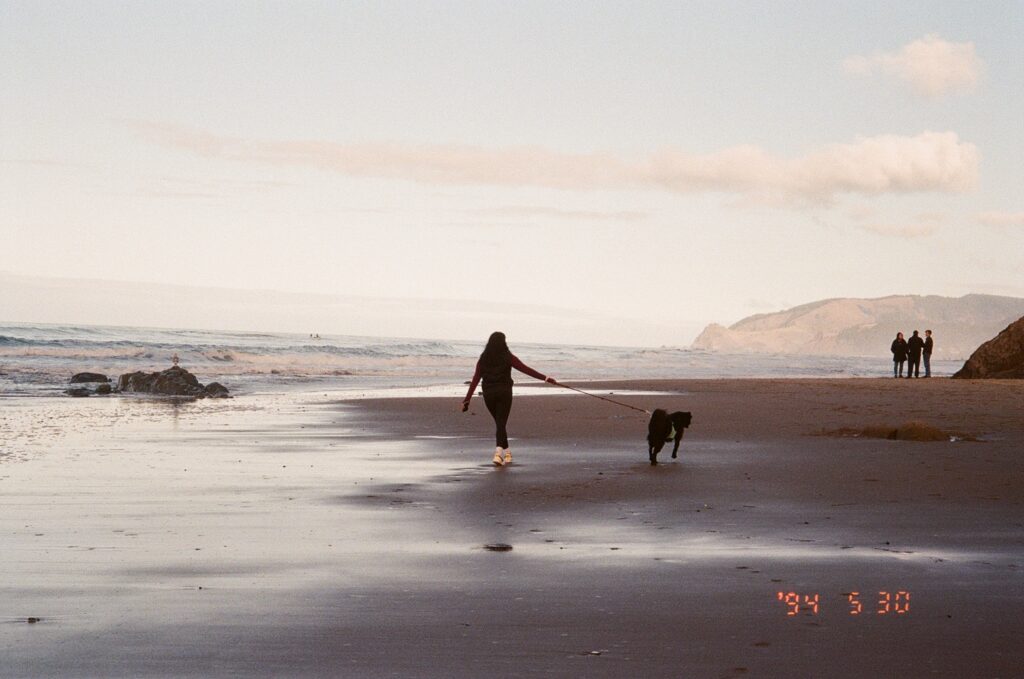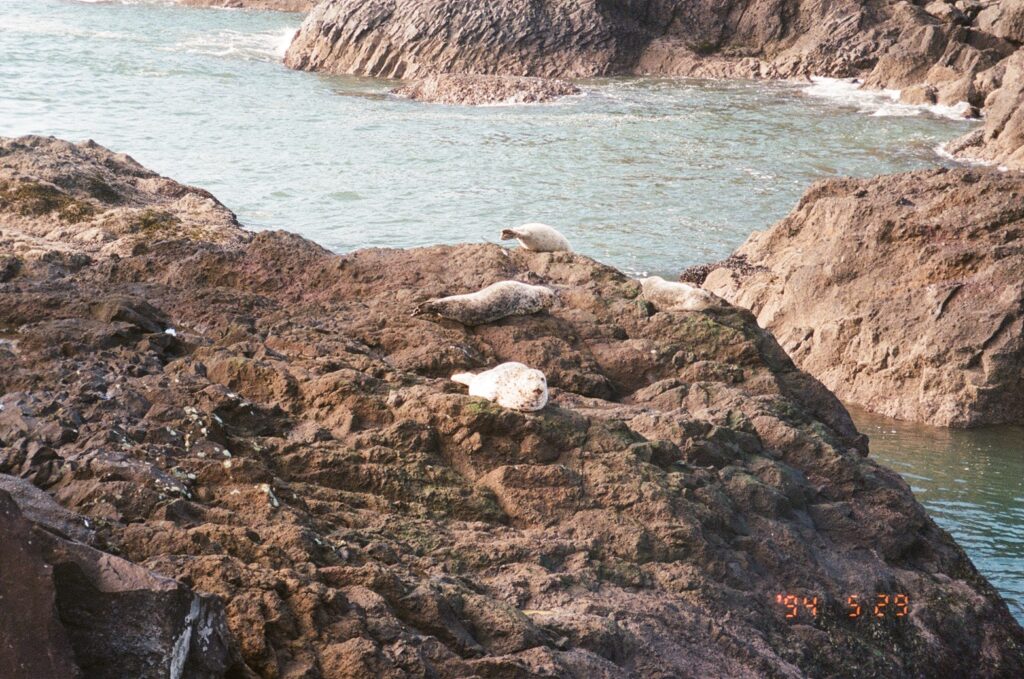In celebration of the timeless connection between people and nature, this week’s blog features a powerful personal essay by OneNature contributor Dehara Weeraman, titled “The Mountains Are Calling and I Must Go.”
Rooted in personal experience and cultural memory, Dehara’s essay explores how national parks—from Virginia’s Blue Ridge Mountains to Sri Lanka’s Minneriya—offer more than just landscapes. They are sanctuaries of biodiversity, sources of inspiration, and places where generations gather to reflect, protect, and reconnect.
Through childhood memories, conservation insights, and reflections on belonging and land stewardship, Dehara reminds us what’s at stake—and what’s possible—when we fight to protect these wild places.
We hope you enjoy reading her story as much as we did.

Oregon Coastal beach walk with dog pic courtesy Dehara Weeraman
The Mountains are Calling and I Must Go
Title from Letter to Sarah, written by John Muir. 9/3/1873, Yosemite Valley
National Parks: a place to reconnect with oneself while wholly immersed in natural beauty and an abundance of wildlife. An adventure that not only teaches you history and culture, but focuses your mind to remember a key thing we often forget, protecting our planet’s natural beauty for future generations to bear witness.
On June 30, 1864, president Abraham Lincoln signed the Yosemite Grant Act. This act transferred the responsibility and management of Yosemite Valley, and the Mariposa Grove, to the state of California, creating the very first national park in the world. The signing of this act set a precedent for the maintaining and protection of national natural resources solely for public use, resort, and recreation.
The desire for national parks burgeoned from the desire to escape the rapidly growing industrialization of the American urban city, as well as the rise of automobiles. While Yellowstone became the first national park in 1872, the national park service was not established until 1916; prior to that, the nation’s parks were managed and supervised by the war, agriculture, and interior departments of the U.S. government. Of course, one can’t talk about national parks today without recognizing that the establishment of national these parks in the US and around the world has a complicated history https://www.npca.org/case-studies/national-parks-are-native-lands
Each year over 300 million people spend time visiting a U.S. national park; so much so that in 2023, the national parks service contributed $55.6 billion to the U.S. economy. While visiting said parks, visitors often ventured around the surrounding towns, spending an estimated $26.4 billion. Because of this expenditure, national park visitors supported over 400,000 jobs in the U.S.
There’s a special place in my heart for national parks, not just in the U.S., but all around the world. The first national park I ever visited was the Shenandoah National Park along the Blue Ridge mountains in Virginia. I was just beginning to embark on what would end up being a lifelong passion in wildlife conservation when my mother suggested we go down to Shenandoah for a long hike. I was beyond ecstatic, I spent the weeks before researching all the wildlife that call Shenandoah National Park home; from black bears to snapping turtles, foxes to star-nosed moles, and even bald eagles and white-tailed deers. What I was most excited about this trip was that I would get to pick the brains of all the knowledgable park rangers. I was full of questions and positively bursting with earnest excitement about wildlife.

Oregon Coast pic courtesy Dehara Weeraman
When it comes to land stewardship, I learned at a young age just how important a stewards role is to nature and wildlife conservation. Growing up visiting a country like Sri Lanka, I was able to see firsthand the crucial responsibilities of stewardships in combating land degradation while promoting sustainable agriculture and safeguarding biodiversity. When visiting, we always made sure to stop at Minneriya National Park to immerse ourselves in the thick natural beauty; lush green trees and grasslands far as the eye can see, only speckled with abundant wildlife.
This national park is actually home to the largest gathering of Asian elephants in the entire world. It’s also home to the purple-faced langur and the toque macaque, large deer, the endangered Sri Lankan leopard, and much more. When I visited Sri Lanka back in 2023, I detailed my trip in a similar blog post. Looking back at the photographs and videos my parents have stored in our basement of our childhood trips to these parks in SL moved me deeply. You could actually see the changes in the environment. Thanks to consistent conservation efforts mangrove forests have doubled in hectares and the population of the endangered wild Asian elephants have doubled as well.
Success stories like these show us how a commitment to the preservation and restoration of our natural world not only make the world a more engaging and enchanting place; It allows us to grow alongside one another, to marvel in these remarkable moments and come together in celebration of a common interest: the wellbeing of our planet and its inhabitants.
“I feel like [national parks] are one of the last ‘third spaces’ we have,” said a good friend of mine, Caroline Birch, who just so happens to be in the midst of a roadtrip up and down the West Coast, stopping at every forest and park she happens upon, “especially because generally speaking, likeminded individuals tend to find each other there.” When asked how she felt about the possible privatization of national parks, Caroline contended, “it’s like someone telling us we can no longer even stand on the soil where our grandparents once stood… Just about every aspect of natural life has been stripped from the public; our remote work takes us all over the world, separating our communal families, it’s often illegal to collect rainwater, we have no land of our own to grow and tend to food.”
It wasn’t until I moved to New York that I realized how much I took my natural surrounding for granted when I lived in the Washington DC area. I take train rides to hiking spots hours away from me whereas I used to be able to go for a jog and end up along the C&O Canal. In college, I would take a short car ride to hike up a portion of the Blue Ridge mountains. I still have plenty of contact with the natural world, I spend a great deal of my time sitting in parks or along the East River, but I still yearn for the unbeatable access I had to the great outdoors. As a kid, I dreamt of living deep in the wilderness among the trees and wildlife. I dreamt of starry night skies full of life and eating around a wooden dinner table with my wild friends, deers and porcupines, rabbits and hedgehogs.
Today I look to the future and wonder whether the generations after us will share a similar dream.
- Sri Lanka Elephant pix courtesy Dehara Weeraman
- Monkey Sri Lanka pix courtesy Dehara Weeraman
A heartfelt thank you to Dehara Weeraman for sharing this beautiful reflection. As always, we’re honoured to walk alongside such passionate voices in our shared journey toward well-being for people, wildlife, and the planet.
With Gratitude
Beth & OneNature Team


